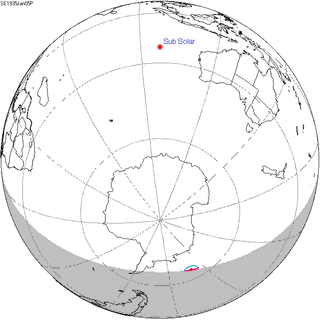Solar eclipse of January 5, 1935
| Solar eclipse of January 5, 1935 | |
|---|---|
| Type of eclipse | |
| Nature | Partial |
| Gamma | −1.5381 |
| Magnitude | 0.0013 |
| Maximum eclipse | |
| Coordinates | 64°42′S 110°12′W / 64.7°S 110.2°W |
| Times (UTC) | |
| Greatest eclipse | 5:35:46 |
| References | |
| Saros | 111 (79 of 79) |
| Catalog # (SE5000) | 9363 |
A partial solar eclipse occurred on January 5, 1935. A solar eclipse occurs when the Moon passes between Earth and the Sun, thereby totally or partly obscuring the image of the Sun for a viewer on Earth. A partial solar eclipse occurs in the polar regions of the Earth when the center of the Moon's shadow misses the Earth. It was the last eclipse of solar saros 111 with the moon's penumbra touching the earth for just 10 minutes.[1]
Related eclipses
Solar eclipses 1935-1938
This eclipse is a member of a semester series. An eclipse in a semester series of solar eclipses repeats approximately every 177 days and 4 hours (a semester) at alternating nodes of the Moon's orbit.[2]
| Solar eclipse series sets from 1935 to 1938 | ||||
|---|---|---|---|---|
| Ascending node | Descending node | |||
| 111 | January 5, 1935 Partial |
116 | June 30, 1935 Partial | |
| 121 | December 25, 1935 Annular |
126 | June 19, 1936 Total | |
| 131 | December 13, 1936 Annular |
136 | June 8, 1937 Total | |
| 141 | December 2, 1937 Annular |
146 | May 29, 1938 Total | |
| 151 | November 21, 1938 Partial | |||
References
- ^ http://eclipse.gsfc.nasa.gov/SEplot/SEplot1901/SE1935Jan05P.GIF
- ^ van Gent, R.H. "Solar- and Lunar-Eclipse Predictions from Antiquity to the Present". A Catalogue of Eclipse Cycles. Utrecht University. Retrieved 6 October 2018.
External links
Wikimedia Commons has media related to Solar eclipse of 1935 January 5.




